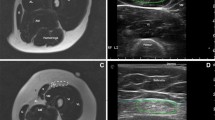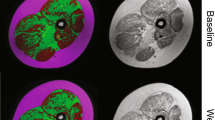Abstract
Oculopharyngeal muscular dystrophy (OPMD) is a rare autosomal dominant muscular dystrophy with late onset and slow progression. The aim of this study was to compare different methods of quantitative MRI in the follow-up of OPMD to semiquantitative evaluation of MRI images and to functional parameters. We examined 8 patients with genetically confirmed OPMD and 5 healthy volunteers twice at an interval of 13 months. Motor function measurements (MFM) were assessed. Imaging at 1.5 T (Siemens Magnetom Avanto) comprised two axial slice groups at the largest diameter of thigh and calf and included T1w TSE, 2-point Dixon for muscular fat fraction (MFF) and a multi-contrast TSE sequence to calculate quantitative T2 values. T1 images were analyzed using Fischer’s semiquantitative 5-point (0–4) scale. MFM and visual scores showed no significant difference over the study period. Overall T2 values increased in patients over the study period from 49.4 to 51.6 ms, MFF increased from 19.2 to 20.7%. Neither T2 values nor MFF increased in controls. Changes in T2 correlated with the time interval between examinations (r 2 = 0.42). In this small pilot trial, it was shown that quantitative muscle MRI can detect subclinical changes in patients with OPMD. Quantitative MRI might, therefore, be a useful tool for monitoring disease progression in future therapeutic trials.





Similar content being viewed by others
References
Brais B (2009) Oculopharyngeal muscular dystrophy: a polyalanine myopathy. Curr Neurol Neurosci Rep 9:76–82
Fischmann A, Gloor M, Fasler S, Haas T, Rodoni Wetzel R, Bieri O, Wetzel S, Heinimann K, Scheffler K, Fischer D (2011) Muscular involvement assessed by MRI correlates to motor function measurement values in oculopharyngeal muscular dystrophy. J Neurol 258:1333–1340. doi:10.1007/s00415-011-5937-9
Mercuri E, Mayhew A, Muntoni F, Messina S, Straub V, Van Ommen GJ, Voit T, Bertini E, Bushby K, Network TREAT-NMDN (2008) Towards harmonisation of outcome measures for DMD and SMA within TREAT-NMD; report of three expert workshops: TREAT-NMD/ENMC workshop on outcome measures, 12th–13th May 2007, Naarden, The Netherlands; TREAT-NMD workshop on outcome measures in experimental trials for DMD, 30th June–1st July 2007, Naarden, The Netherlands; conjoint Institute of Myology TREAT-NMD meeting on physical activity monitoring in neuromuscular disorders, 11th July 2007, Paris, France. Neuromuscul Disord 18:894–903. doi:10.1016/j.nmd.2008.07.003
Kim HK, Laor T, Horn PS, Wong B (2010) Quantitative assessment of the T2 relaxation time of the gluteus muscles in children with Duchenne muscular dystrophy: a comparative study before and after steroid treatment. Korean J Radiol 11:304–311. doi:10.3348/kjr.2010.11.3.304
Gloor M, Fasler S, Fischmann A, Haas T, Bieri O, Heinimann K, Wetzel SG, Scheffler K, Fischer D (2011) Quantification of fat infiltration in oculopharyngeal muscular dystrophy: comparison of three MR imaging methods. JMRI 33:203–210. doi:10.1002/jmri.22431
Paradas C, Llauger J, Diaz-Manera J, Rojas-García R, De Luna N, Iturriaga C, Márquez C, Usón M, Hankiewicz K, Gallardo E, Illa I (2010) Redefining dysferlinopathy phenotypes based on clinical findings and muscle imaging studies. Neurology 75:316–323. doi:10.1212/WNL.0b013e3181ea1564
Vuillerot C, Girardot F, Payan C, Fermanian J, Iwaz J, Lattre DE, Berard C (2009) Monitoring changes and predicting loss of ambulation in duchenne muscular dystrophy with the motor function measure. Dev Med Child Neurol. doi:10.1111/j.1469-8749.2009.03316.x
Bérard C, Payan C, Hodgkinson I, Fermanian J, Group MFMCS (2005) A motor function measure for neuromuscular diseases construction and validation study. Neuromuscul Disord 15:463–470
Fischer D, Kley RA, Strach K, Meyer C, Sommer T, Eger K, Rolfs A, Meyer W, Pou A, Pradas J, Heyer CM, Grossmann A, Huebner A, Kress W, Reimann J, Schröder RJ, Eymard B, Fardeau M, Udd B, Goldfarb L, Vorgerd M, Olivé M (2008) Distinct muscle imaging patterns in myofibrillar myopathies. Neurology 71:758–765. doi:10.1212/01.wnl.0000324927.28817.9b
Coté C, Hiba B, Hebert LJ, Vial C, Remec JF, Janier M, Puymirat J (2011) MRI of tibialis anterior skeletal muscle in myotonic dystrophy type 1. Can J Neurol Sci 38:112–118
Sinclair C, Morrow J, Fischmann A, Hanna M, Reilly M, Yousry T, Golay X, Thornton J (2011) Skeletal muscle MRI-determined fat fraction and myometric strength in inclusion body myositis and Charcot-Marie-Tooth disease Type 1A. Neuromuscul Disord 21:S5. doi:10.1016/S0960-8966(11)70014-1
Bryan WW, Reisch JS, McDonald G, Herbelin LL, Barohn RJ, Fleckenstein JL (1998) Magnetic resonance imaging of muscle in amyotrophic lateral sclerosis. Neurology 51:110–113
Gaeta M, Scribano E, Mileto A, Mazziotti S, Rodolico C, Toscano A, Settineri N, Ascenti G, Blandino A (2011) Muscle fat fraction in neuromuscular disorders: dual-echo dual-flip-angle spoiled gradient-recalled mr imaging technique for quantification—a feasibility study. Radiology 259:487–494. doi:10.1148/radiol.10101108
Meola G, Bugiardini E, Cardani R (2011) Muscle biopsy. J Neurol. doi:10.1007/s00415-011-6193-8
Huang Y, Majumdar S, Genant HK, Chan WP, Sharma KR, Yu P, Mynhier M, Miller RG (1994) Quantitative MR relaxometry study of muscle composition and function in Duchenne muscular dystrophy. JMRI 4:59–64
Patten C, Meyer RA, Fleckenstein JL (2003) T2 mapping of muscle. Semin Musculoskel Radiol 7:297–305. doi:10.1055/s-2004-815677
Skinner TE, Glover GH (1997) An extended two-point Dixon algorithm for calculating separate water, fat, and B0 images. Magn Reson Med 37:628–630
Allerhand A (1966) Analysis of carr—purcell spin-echo nmr experiments on multiple-spin systems. I. the effect of homonuclear coupling. J Chem Phys 44:1–9
Acknowledgments
This study was supported by the Lorenzo Piaggio Foundation, Switzerland. The Institute of Radiology receives an unspecified general grant from Bracco. The sponsor played no role in matters of design, collection, analysis, interpretation of data, and writing the report. The authors would like to thank Tanja Haas for the MRI measurements. We also thank the reviewers for their helpful comments.
Conflicts of interest
The authors declare no conflict of interest.
Author information
Authors and Affiliations
Corresponding author
Electronic supplementary material
Below is the link to the electronic supplementary material.
Rights and permissions
About this article
Cite this article
Fischmann, A., Hafner, P., Fasler, S. et al. Quantitative MRI can detect subclinical disease progression in muscular dystrophy. J Neurol 259, 1648–1654 (2012). https://doi.org/10.1007/s00415-011-6393-2
Received:
Revised:
Accepted:
Published:
Issue Date:
DOI: https://doi.org/10.1007/s00415-011-6393-2




